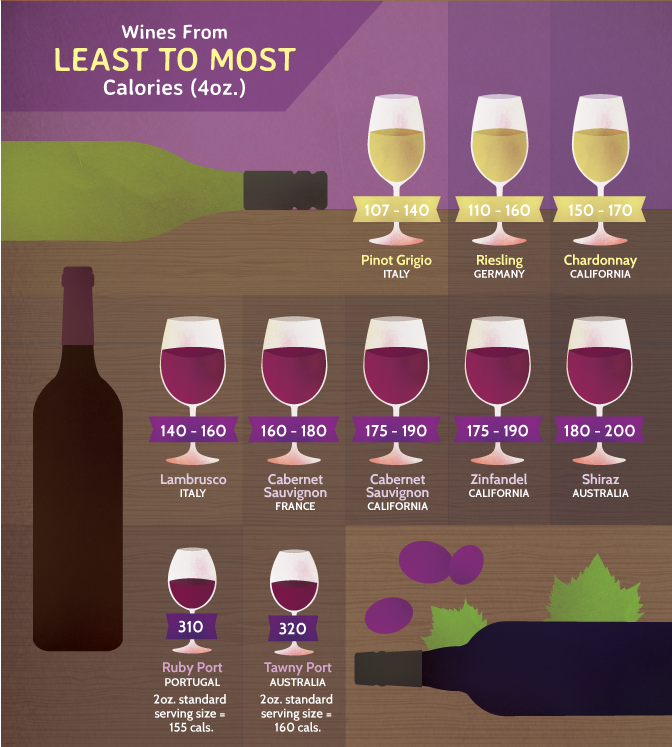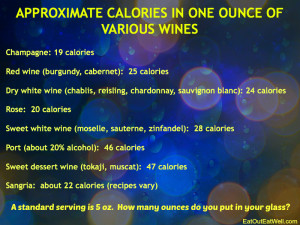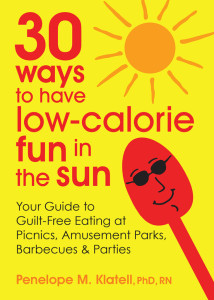
Source: Fix.com
calories in white wine
Is There Less Alcohol And Fewer Calories In a Serving Of Wine Than There Is In Beer Or A Standard Drink?
 That’s not a trick question. A standard alcoholic drink (in the US) is a drink that contains the equivalent of 14.0 grams (0.6 ounces) of pure alcohol, or the amount usually found in:
That’s not a trick question. A standard alcoholic drink (in the US) is a drink that contains the equivalent of 14.0 grams (0.6 ounces) of pure alcohol, or the amount usually found in:
- 12 ounces of beer
- 8 ounces of malt liquor
- 5 ounces of wine (not dessert wine or port)
- 1.5 ounces or a “shot” of 80-proof distilled spirits or liquor (gin, rum, vodka, or whiskey, etc.)
So, if you’re comparing a standard portion of one form of alcohol to another, there is the approximate equivalent of alcohol in each drink.
But – take note of the portion sizes. If the hand that pours puts 10 ounces of wine into a large wine glass (not unheard of) you are actually getting twice the amount of alcohol that you would get in a 12 ounce bottle of beer of a standard shot glass (1.5 ounces) of 80-proof liquor.
Calories From Alcohol Don’t Make You Feel Full
When you drink your calories your body doesn’t actually feel satisfied. Except for perhaps milk or other protein drinks, fluid intake doesn’t typically trigger production of the hormones that tell your brain that you’ve fed your stomach. Most liquid calories don’t produce “satiety” or the feeling of “being full,” which your brain takes as the cue to stop eating.
This is especially true if you’re slowly sipping your drink — but research has shown that even if the temporary bloat you feel after rapidly downing a beer is no substitute for satiety.
(FYI: even if you don’t feel full, the alcohol you’ve drunk still has 7 calories per gram compared to 4 calories per gram for carbohydrates and protein and 9 calories per gram for fat.)
How Many Calories Are In Your Glass Of Wine?
The standard serving of wine (5 ounces) is probably visually smaller than you think. Wine glasses can generally hold a lot more, and depending on who’s pouring, can be filled with many more than 5 ounces.
Most standard servings of wine have 125-150 calories, but the calories can double depending on the size of the glass and how far it’s filled up. Sweet and dessert wines are more caloric than table wine and champagne, although the serving size is generally smaller.
For comparison, on average, a 12 ounce bottle of beer has around 153 calories and 1.5 ounces (a jigger) of 80 proof liquor has around 97 calories.
As an experiment, try filling up your usual wine glass – using water—to simulate the amount of wine you would usually pour, and then measure that amount in a measuring cup. You might be shocked to find that the serving you’re used to pouring is double the standard serving size.
You may have your preference – most of us do – but whether it’s red, white, dry, sweet, or sparkling, it is really easy to overlook the calories in those long-stemmed glasses.
If you have dessert wine after dinner it’s about double the calories per ounce although the standard serving is less: usually 2 to 3 ounces. So add on about another 100 to 150 calories for each glass of that smooth dessert wine.
Approximate Calories in One Ounce Of Various Wines:
Champagne: 19 calories
Red wine (burgundy, cabernet): 25 calories
Dry white wine (Chablis, reisling, chardonnay, sauvignon blanc): 24 calories
Rose: 20 calories
Sweet white wine (moselle, sauterne, zinfandel): 28 calories
Port (about 20% alcohol): 46 calories
Sweet dessert wine (tokaji, muscat): 47 calories
Sangria: about 22 calories (recipes vary)
For more tips get 30 Ways to Have Low-Calorie Fun in the Sun: Your Guide to Guilt-Free Eating at Picnics, Amusement Parks, Barbecues & Parties available from Amazon and Barnes & Noble.
